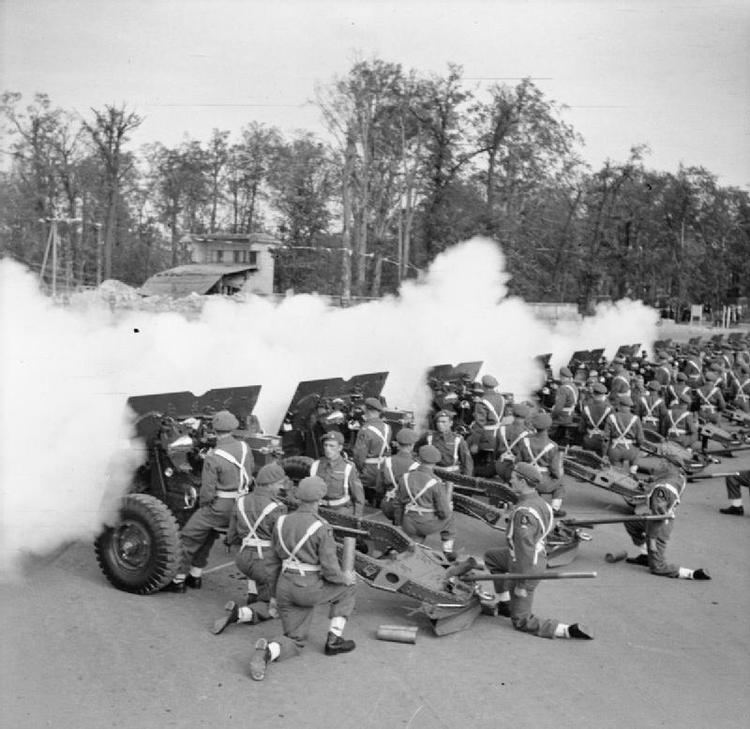Role Field artillery Part of 1st Artillery Brigade | Size Five batteries | |
 | ||
Active 27 August 1938 – presentbut all the individual batteries except one have served since creation between 1793 & 1811 | ||
3rd Regiment Royal Horse Artillery is a regiment of the Royal Horse Artillery in the British Army. They are currently based at Albemarle Barracks, Northumberland, England.
Contents
The regiment was constituted in 1939 out of existing batteries. Two of the batteries have served continuously since the 1790s. Two others have served continuously since their formation in the period 1805-1811 during the Napoleonic wars. M Battery, by contrast, has served continuously since 1993.
Formation
The basic organic unit of the Royal Artillery was, and is, the Battery. Prior to May 1938, when grouped together they formed brigades, in the same way that infantry battalions or cavalry regiments were grouped together in brigades. At the outbreak of the First World War, a field artillery brigade of headquarters (4 officers, 37 other ranks), three batteries (5 and 193 each), and a brigade ammunition column (4 and 154) had a total strength just under 800 so was broadly comparable to an infantry battalion (just over 1,000) or a cavalry regiment (about 550). Like an infantry battalion, an artillery brigade was usually commanded by a Lieutenant-Colonel. After May 1938, brigades were redesignated as regiments and on 27 August 1938, III Brigade Royal Horse Artillery at Abbassia, Egypt was redesignated as 3rd Regiment Royal Horse Artillery.
Also in 1938, artillery brigades were reorganized from three six-gun batteries to two 12-gun batteries. Rather than disband existing batteries, they were instead linked in pairs. As a result, D and J Batteries formed D/J Battery on 11 May 1938 and M and P Batteries were linked as M/P Battery on the same date. This was the regiment's structure on formation but in the event the batteries were unlinked within months (in September 1939) and the regiment operated with four batteries.
Second World War
By the outbreak of the Second World War, the regiment was still in Egypt and on 16 October 1939 was assigned to Headquarters Royal Artillery Group (Middle East Reserve) as an anti-tank regiment armed with 2 pounder guns. M Battery, however, was permanently attached to the Armoured Division (Egypt) (later the 7th Armoured Division, the "Desert Rats"). In March 1941, P Battery left the regiment to join 6th Regiment, Royal Horse Artillery in the United Kingdom. In practice just the title was transferred; the personnel and equipment were distributed amongst D, J and M batteries making them up to eight-gun units. On 1 March 1941, the regiment joined M Battery in 7th Support Group and all three batteries were redesignated as anti-tank. The regiment took part in the final attempt to lift the Siege of Tobruk, Operation Crusader (18 November – 10 December) – notably the Battle of Sidi Rezegh where Second Lieutenant George Ward Gunn (J Battery) earned the Victoria Cross for his bravery during an attack by 60 German Tanks. 3rd RHA commemorate this by wearing a red backing to the cypher. On 26 April 1954, J Battery was awarded the Honour Title "Sidi Rezegh" in recognition of this action. The regiment was rearmed with 25 pounders after Sidi Rezegh, and the batteries were redesignated as field artillery on 8 September 1942.
The regiment left the 7th Support Group on 8 February 1942 (the day before it was reformed as the 7th Motor Brigade) and was assigned directly to the 7th Armoured Division; it remained with the division for the rest of the war. The regiment supported the 7th Armoured Division during the rest of the Western Desert Campaign taking part in the Battle of Gazala (26 June – 21 June 1942), the Defence of the El Alamein Line (1 – 27 July), the Battle of Alam el Halfa (30 August – 7 September), and the Battle of El Alamein (23 October – 4 November). It then took part in the Tunisia Campaign including the Battles of Medenine (6 March 1943), Mareth (16 – 23 March), Akarit (6 and 7 April), Enfidaville (19 – 29 April), and Tunis (5 – 12 May).
The regiment was withdrawn to Libya to rest and refit thereby missing the Sicilian Campaign. It next took part in the Italian Campaign: the Salerno Landings (9 – 18 September 1943), the Capture of Naples (22 September – 1 October), and the Volturno Crossing (12 – 15 October). It then returned to the United Kingdom, arriving on 4 January 1944. It continued to support 7th Armoured Division, as a follow up formation, following the Normandy Landings In 1945, the regiment led the Allied Victory parade in Berlin, and fired the Victory Salute.
Post War
After World War II the regiment served in the UK, West Germany, Aden, Egypt, Kenya, Hong Kong and Cyprus.
The regiment has served in the Former Republic of Yugoslavia. In 1993 N Battery (The Eagle Troop) joined the regiment, and M Battery was amalgamated with Headquarters Battery to form M (Headquarters) Battery.
M(HQ) Bty, Radar Troop was deployed to Bosnia in 1994 and again in 1995 and 1996 on operational duties in Sarajevo and then Sanski Most during the balkan conflict.
Under Army 2020, it will provide force support to the Adaptable Force. In 2013 it re-rolled from AS-90s to L118 Light Guns. From 1 March 2015, the 105th Regiment Royal Artillery will be paired with this regiment. Under Army 2020 Refine the Regiment will support one of the new STRIKE Brigades, initially utilising the L118 Light Gun, but ultimately using a new wheeled self-propelled gun that is set to be procured in the mid-2020s.
Batteries
The batteries are as follows:
Equipment
The regiment has been equipped with the following weapons during its existence:
